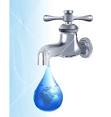Cities bear rising cost of keeping water safe to drink
JOHN SEEWER, Associated Press
TOLEDO, Ohio (AP) — Standing at the edge of the Great Lakes, the world’s largest surface source of fresh water, this city of 280,000 seems immune from the water-supply problems that bedevil other parts of the country. But even here, the promise of an endless tap can be a mirage.
Algae blooms in Lake Erie, fed by agriculture runoff and overflowing sewers, have become so toxic that they shut down Toledo’s water system in 2014 for two days. The city is considering spending millions of dollars to avoid a repeat.
Similar concerns about water quality are playing out elsewhere. Farm fertilizers, discarded pharmaceuticals, industrial chemicals and even saltwater from rising oceans are seeping into many of the aquifers, reservoirs and rivers that supply Americans with drinking water.
Combating these growing threats means cities and towns must tap new water sources, upgrade aging treatment plants and install miles of pipeline, at tremendous cost.
Consider tiny Pretty Prairie, Kansas, less than an hour’s drive west of Wichita, where the water tower and cast-iron pipes need to be replaced and state regulators are calling for a new treatment plant to remove nitrates from farm fertilizers. The fixes could cost the town’s 310 water customers $15,000 each.
Emily Webb never gave a second thought to the town’s water until she became pregnant almost two years ago. That’s when she learned through a notice in the mail that the water could cause what’s known as “blue baby” syndrome, which interferes with the blood’s ability to carry oxygen.
“It just kind of scared me,” she said. “Now we don’t drink it at all.”
Instead, she and her husband stock up on well water from her parents’ home and buy bottled water even though health officials say the risk is limited to infants. When it comes time to buy their first home, she said, they will look somewhere else.
Pretty Prairie’s leaders hope to find a less expensive solution. They say the cost of a new treatment plant would drive people away and threaten the farm town’s survival.
Across the country, small towns and big cities alike are debating how much they can afford to spend to make contaminated water fit for drinking.
Cash-strapped cities worry that an unfair share of the costs are being pushed onto poor residents. Rural water systems say they can’t expect the few people they serve to pay for multimillion-dollar projects.
The U.S Conference of Mayors, in a report released this summer, found spending by local governments on all water-supply projects nearly doubled to $19 billion between 2000 and 2012. Despite a slowdown in recent years, it remained at an all-time high, the report said.
“We have a real dilemma on our hands,” said Richard Anderson, author of the report. “We know we need to increase spending on water, but many houses can’t afford it, and Congress won’t increase funding.”
In California’s Central Valley, low-income farming communities have gone without clean water for years because they don’t have money to build plants to remove uranium, arsenic and nitrates. Drinking fountains at schools have been put off limits, and families spend a large share of their income on bottled water.
A study released in June by the U.S. Geological Survey found nearly one-fifth of the groundwater used for public drinking systems in California contained excessive levels of potentially toxic contaminants.
Compounding the problem is the drought. Because farmers are using more groundwater for irrigation, contaminants are becoming more concentrated in the aquifers and seeping into new wells.
The drought has pushed Los Angeles to plan for the nation’s largest groundwater cleanup project, a $600 million plan to filter groundwater contaminated with toxic chemicals left over from the aerospace and defense industry. Some of the water will be drawn from polluted wells abandoned 30 years ago.
In the Midwest, where shortages typically have not been a concern, more attention is being paid to farming’s effect on drinking water supplies.
Minnesota’s governor this year ordered farmers to plant vegetation instead of crops along rivers, streams and ditches to filter runoff. The water utility in Des Moines, Iowa’s largest city, is suing three rural counties to force tighter regulations on farm discharges.
And in the wake of Toledo’s water crisis, Ohio has put limits on when and where farmers can spread fertilizer and manure on fields.
“But no one really knows how well that works,” said Chuck Campbell, the city’s water treatment supervisor.
Given that, the city has spent $5 million in the past year to bolster its ability to cleanse water drawn from Lake Erie. It is planning a renovation that could approach $350 million and include a system that uses ozone gas to destroy toxins produced by the algae. A 56 percent water rate increase is footing most of the bill.
In many coastal areas, rising seas mean saltwater can intrude into underground aquifers and in some cases ruin existing municipal wells. It’s especially problematic in the Southeast, from Hilton Head Island in South Carolina to Florida’s seaside towns near Miami.
“Nature’s calling the shots and we’re reacting,” said Keith London, a city commissioner in Hallandale Beach, Florida, where six of eight freshwater wells are no longer usable.
The city is considering relocating wells, upgrading its treatment plant or buying water from a neighboring town.
The water that comes out of the tap in the oceanside town of Edisto Beach, South Carolina, is so salty that it corrodes dishwashers and washing machines within just a few years, resident Tommy Mann said.
While technically safe to drink, it tastes so bad that the town gives away up to five gallons of purified water a day to residents and vacationers.
Voters narrowly rejected a proposal two years ago that would have doubled water rates to pay for an $8.5 million reverse-osmosis filtering system.
Said Mann: “We’re living in a beautiful little town with Third World water.”
[livemarket market_name="KONK Life LiveMarket" limit=3 category=“” show_signup=0 show_more=0]




No Comment